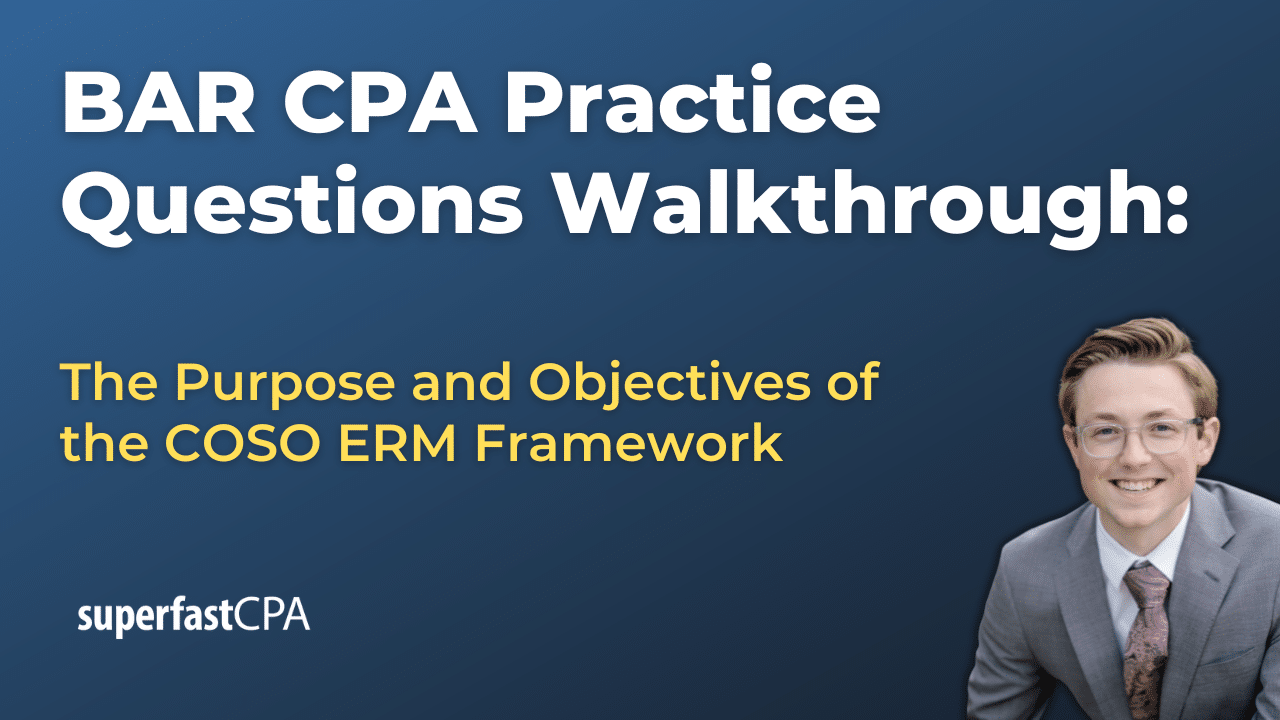In this video, we walk through 5 FAR practice questions teaching about preparing consolidated financial statements. These questions are from FAR content area 1 on the AICPA CPA exam blueprints: Financial Reporting.
The best way to use this video is to pause each time we get to a new question in the video, and then make your own attempt at the question before watching us go through it.
Also be sure to watch one of our free webinars on the 6 “key ingredients” to an extremely effective & efficient CPA study process here…
Preparing Consolidated Financial Statements
Consolidated financial statements present the financial position and performance of a parent company and its subsidiaries as a single economic entity. Here are the key steps and considerations in preparing these statements:
Elimination of Intercompany Transactions and Accounts
To prevent double counting and reflect the true economic position of the group, all intercompany transactions and balances must be eliminated during consolidation. This includes:
- Intercompany Receivables and Payables:
All receivables and payables between the parent and subsidiary must be eliminated. For example, if Summit Enterprises has accounts receivable from its subsidiary, Mountain Tech, these amounts are eliminated from the consolidated accounts. - Intercompany Sales of Inventory:
Profits from intercompany sales of inventory that have not been sold to third parties must be eliminated, and the remaining profit must be eliminated from ending inventory. For instance, if Vertex Industries sells inventory to Summit Corp. with a markup, and Summit Corp. sells only a portion of that inventory to external customers, the profit from the unsold portion must be eliminated from inventory, and profit from the sold portion must be eliminated from cost of goods sold.- Example Calculation:
Vertex Industries sells inventory to Summit Corp. for $226,000 with a markup of 13%. - Original cost = $200,000.
Intercompany profit = $26,000.
If 48% of the inventory is sold, then profit eliminated from COGS = $26,000 * 48% = $12,480.
Profit eliminated from ending inventory = $26,000 * 52% = $13,520.
- Example Calculation:
- Intercompany Sales of Equipment:
When equipment is sold between companies, the intercompany gain is eliminated. If the equipment is later sold to an outside party, the gain is calculated based on the original cost and accumulated depreciation, as if the intercompany sale never occurred.- Example Calculation:
TechCo Inc. sells equipment to Bright Solutions Ltd. for $200,000. Original cost = $140,000, accumulated depreciation = $50,000.
Net book value = $90,000.
If Bright Solutions Ltd. sells to an outside party for $230,000, the gain is $230,000 – $90,000 = $140,000.
- Example Calculation:
Noncontrolling Interest in Consolidated Equity
Noncontrolling interest (NCI) represents the portion of a subsidiary’s equity that is not owned by the parent company. It is reported in the consolidated equity section and is calculated as follows:
- Beginning Noncontrolling Interest:
Based on the fair market value of the subsidiary’s equity not owned by the parent.- Example Calculation:
If GreenTech Solutions owns 85% of Eco Innovations Ltd., with a total fair market value of $300,000, the NCI at the beginning is $300,000 * 15% = $45,000.
- Example Calculation:
- Noncontrolling Interest in Net Income:
Calculated as the subsidiary’s net income multiplied by the noncontrolling percentage. - Noncontrolling Interest in Dividends:
Calculated as the dividends paid by the subsidiary multiplied by the noncontrolling percentage. - Ending Noncontrolling Interest:
Calculated by adjusting the beginning noncontrolling interest with the noncontrolling interest in net income and dividends. - Example Calculation:
If Eco Innovations Ltd. has net income of $65,000 and dividends of $15,000, the NCI in net income = $65,000 * 15% = $9,750.
NCI in dividends = $15,000 * 15% = $2,250.
Ending NCI = $45,000 + $9,750 – $2,250 = $52,500.
Treatment of Assets, Liabilities, and Equity
- Assets and Liabilities:
All of the subsidiary’s assets and liabilities are included in the consolidated balance sheet. Any intercompany balances are eliminated. Assets and liabilities are recorded at their fair values at the acquisition date, with any excess recorded as goodwill. - Equity:
Only the parent’s equity accounts (common stock, APIC, and retained earnings) are included in the consolidated financial statements. The subsidiary’s equity is not included, except for the portion related to noncontrolling interest.
Impact of Acquisitions on Consolidation
When a parent acquires a controlling interest in a subsidiary during the year, only the post-acquisition net income of the subsidiary is included in the consolidated financial statements.
- Net Income Inclusion:
The net income of the subsidiary from the acquisition date to the year-end is included in the consolidated net income. The parent’s share of this net income is included in the consolidated retained earnings.- Example Calculation:
If Orion Enterprises acquires 80% of Comet Solutions on March 1st, and Comet’s net income after March 1st is $180,000, then Orion’s share is $180,000 * 80% = $144,000.
- Example Calculation:
- Consolidated Retained Earnings:
The consolidated retained earnings include the parent’s retained earnings and the parent’s share of the subsidiary’s post-acquisition net income.- Example Calculation:
Orion Enterprises’ retained earnings = $1,000,000.
Parent’s share of Comet’s post-acquisition net income = $144,000.
Consolidated retained earnings = $1,000,000 + $144,000 = $1,144,000.
- Example Calculation:
These steps outline the key processes and calculations involved in preparing consolidated financial statements, focusing on the elimination of intercompany transactions, treatment of noncontrolling interest, and the impact of acquisitions.













